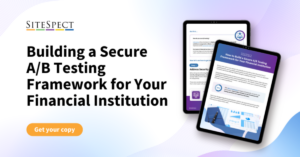The Power and Importance of Micro Conversions
By Kate Orchard
November 12, 2018
Share
If you’re overseeing an A/B testing and optimization program, you know how critical it is to communicate the business impact of your efforts quickly and clearly. For most of us, we reflexively zero in on the end goal.
 If you’re an ecommerce, that’s probably purchases or revenue per visit. If you’re a financial institution, maybe it’s opened accounts. For a university, course enrollments or applications submitted. You get the idea. Obviously, optimizing these KPIs are crucial. But, only focusing here will be limiting. It would be just like working really hard to plan and execute an amazing party, but then forgetting to send the invites. Anyone who gets there is having a blast, but most people don’t.
If you’re an ecommerce, that’s probably purchases or revenue per visit. If you’re a financial institution, maybe it’s opened accounts. For a university, course enrollments or applications submitted. You get the idea. Obviously, optimizing these KPIs are crucial. But, only focusing here will be limiting. It would be just like working really hard to plan and execute an amazing party, but then forgetting to send the invites. Anyone who gets there is having a blast, but most people don’t.
What is a Micro Conversion?
You know what a conversion is. A micro conversion is an action that a site visitor takes before reaching your defined conversion. Google Analytics does a good job defining the two and it will show you how to track them as well. It’s a great starting point if you’re not A/B testing yet (if you are, SiteSpect offers complete analytics built in). Here’s an ecommerce example of the sales funnel including micro conversions: You’re shopping for a new shirt. You use the onsite search, and from here you scroll down. Maybe you go through several product list pages. Eventually you click on an item, and then see different angles, colors, sizes, and prices. Maybe you add it to your cart, but then you go back to the search result pages. You keep on going like that until eventually you’re ready to check out and you go to your cart and finish the process. Here are just some of the micro conversions:
- Searching
- Scrolling
- Clicking through pages
- Clicking multiple views on the product image
- Hovering your mouse over the item price
- Clicking color and size options
The Power of Micro Conversions
In the above example, completing each of these steps helps you along your journey to conversion. Most marketers I talk to put a lot of thought into perfecting their customer journey, but then it doesn’t translate when they go to communicate the success of their optimizations efforts. That pressure means some metrics, like scrolling depth or mouse hovers, go unanalyzed — leaving revenue on the table.
It’s always exciting to A/B test something huge with a big impact, for example, the steps in your check out flow or the copy in your promotions. However, these A/B tests are time consuming, resource heavy, and slower to release. Smaller scale A/B tests like adjusting the placement of your customer service phone number can be built and released in a few minutes with SiteSpect. In one case, this quick effort resulted in a 5% uplift in checkouts — valued at $10 million annual additional revenue. Now, imagine executing just 5 of these minimal effort, smaller scale A/B tests every month. You’re making an enormous revenue impact.
Practical Tips to Optimize Micro Conversions
Start by doing a thorough site analysis. If you don’t have the resources for this, Optimization Consultants at SiteSpect can do this for you as part of our Professional Services. Next, it can be helpful to list out the steps a typical visitor on your site would take on the way to conversion. It’s counterintuitive, but here, start working backwards away from conversion. You’ve probably optimized Add to Cart or Submit components of your site. Now move on to your search results, product details, image close ups, and so on.
You’ll find that each of these successful small optimizations will bring in small revenue increases, like in the above case studies. Each of these small increases will not only add up to major revenue but will also funnel more visitors through to conversion. The power of each of these micro conversions is that they end up supporting your KPI. You really can’t optimize without them.
Case Studies with Big Impact
- This brand added a CTA to out of stock items, asking customers to enroll in an email list for out of stock items. User engagement increased 150%, meaning more customers return to buy these items when they are in stock. The expected revenue bump is £200,000 annually.
- This ecommerce with a huge inventory personalized their navigation menu to help customers find what they were looking for. Streamlining the search and navigation process led to a $900,000 increase in daily revenue.
- This university tested personalized images on their forms pages. The winning variation increased submissions by 2%, which correlates to a projected $1,000,000 annual revenue increase.
- This retailer A/B tested images of clothing on models against flat clothing images. They measured clicks on product details and saw no difference in this micro conversion. This was actually a huge win, since images without models require much fewer resources to produce.
Check out this ebook for more case study ideas, and click here for more case study blogs. To learn more about SiteSpect, visit our website.
Share
Suggested Posts
Subscribe to our blog:





